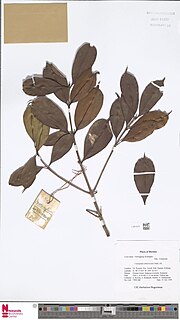
Cratoxylum arborescens is a plant in the family Hypericaceae. The specific epithet arborescens is from the Latin meaning "tree-like".

Cratoxylum maingayi is a plant in the family Hypericaceae. It is named for the botanist Alexander Carroll Maingay.
Alangium nobile is a tree in the dogwood family Cornaceae. The specific epithet nobile is from the Latin meaning "noble" or "distinguished", likely referring to the growth habit.
Anisophyllea beccariana is a tree of tropical Asia in the family Anisophylleaceae. It is named for the Italian botanist Odoardo Beccari.
Anisophyllea corneri is a tree of tropical Asia in the family Anisophylleaceae. It is named for the English botanist Edred John Henry Corner.
Anisophyllea disticha is a plant of tropical Asia in the family Anisophylleaceae. The specific epithet disticha is from the Latin meaning "2-ranked", referring to the leaf arrangement.
Anisophyllea ferruginea is a tree of Borneo in the family Anisophylleaceae. The specific epithet ferruginea is from the Latin meaning "rust-coloured", referring to the leaf hairs.
Anisophyllea nitida is a tree of Borneo in the family Anisophylleaceae. The specific epithet nitida is from the Latin meaning "polished", referring to the shiny appearance of the upper leaf surface.
Canarium fuscocalycinum is a tree of Borneo in the incense tree family Burseraceae. The specific epithet fuscocalycinum is from the Latin meaning "dark calyx".
Canarium littorale is a tree found in tropical Asia and is a member of the incense tree family Burseraceae. The specific epithet littorale is from the Latin meaning "of the seashore", referring to its habitat.
Canarium patentinervium is a tree of tropical Asia in the incense tree family Burseraceae. The specific epithet patentinervium is from the Latin meaning "spreading nerves", referring to the leaf veins.
Canarium pseudopatentinervium is a plant in the incense tree family Burseraceae. The specific epithet pseudopatentinervium is from the Latin meaning "false patentinervium", referring to the species' resemblance to Canarium patentinervium.
Canarium pseudopimela is a tree of Borneo in the incense tree family Burseraceae. The specific epithet pseudopimela is from the Latin meaning "false pimela", referring to the species' resemblance to Canarium pimela.
Canarium sarawakanum is a tree of Borneo in the incense tree family Burseraceae. The specific epithet sarawakanum is from the Latin, referring to the species being native to Sarawak.
Glyptopetalum palawanense is a tree in the family Celastraceae. The specific epithet palawanense refers to the species being native to the island of Palawan in the Philippines.
Hopea sangal is a tree in the family Dipterocarpaceae. It is native to tropical Asia.
Melicope subunifoliolata is a plant of Borneo in the family Rutaceae. The specific epithet subunifoliolata is from the Latin meaning "nearly one leaf", referring to the almost unifoliolate leaves.

Melicope denhamii is a plant in the family Rutaceae. It is named for the 19th century Royal Navy captain Henry Mangles Denham.
Glycosmis macrantha is a tree of Borneo in the family Rutaceae. The specific epithet macrantha is from the Greek meaning "large flower".
Glycosmis superba is a plant of Borneo in the family Rutaceae. The specific epithet superba is from the Latin meaning "splendid", referring to the leaves.



